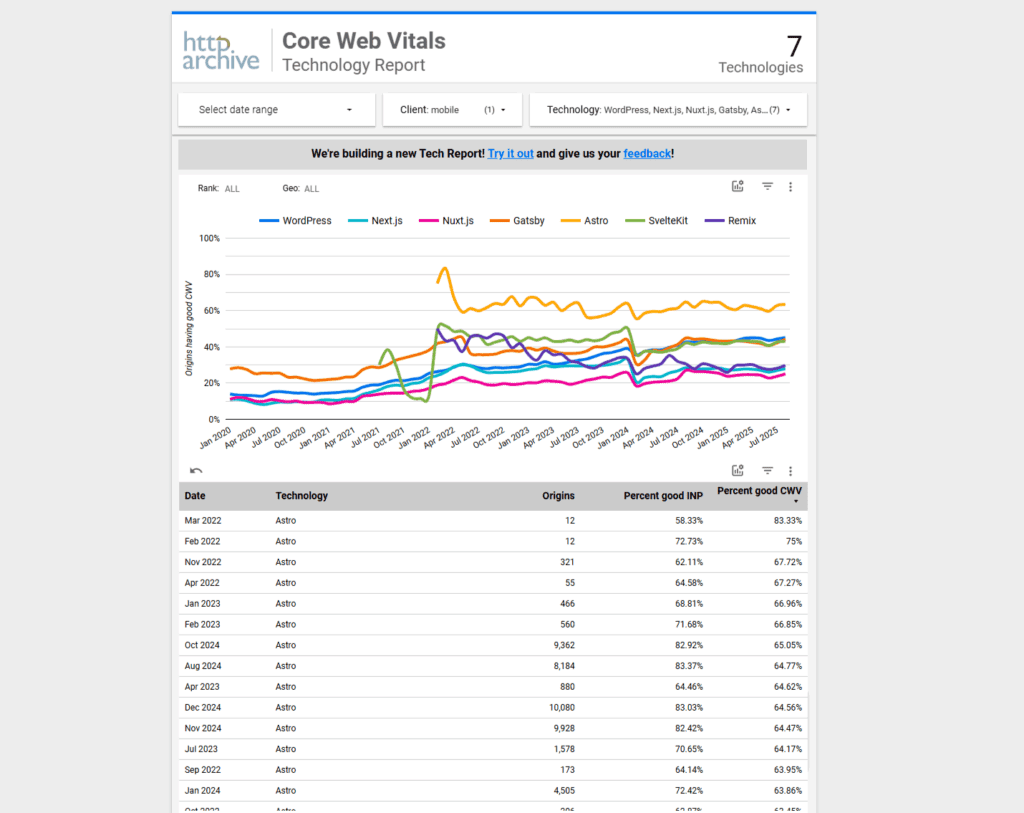React originated at Facebook (Meta) circa 2011, formalized as open source in 2013. Its declarative component model, virtual DOM, and unidirectional data flow challenged the stateful jumble of earlier frontends. Over time, React grew a vast ecosystem: state libraries (Redux, Zustand), routing, SSR and hydration patterns, and meta-frameworks like Next.
By the late 2010s and early 2020s, React became the de facto choice for building large, dynamic web applications. But as use grew, so did complexity—bundle sizes ballooned, time-to-interactive lagged, and SSR/SSG tooling became mandatory to address performance.
Astro is newer: publicly introduced around 2021 by Fred K. Schott and collaborators. Its core idea: shift the default cost of JavaScript execution off the client. Astro popularized the islands architecture (aka selective hydration), where most of a page is static HTML, and only “island” components that need interactivity get hydrated to the client.
Over successive releases (now into Astro 5.x), it has acquired features like a “Content Layer” API for flexible content sourcing, server islands (server-rendered components that hydrate selectively), and tighter hybrid rendering capabilities.
By 2025, Astro has gained traction: in the 2024 State of JavaScript, it led in interest, retention, and positivity metrics, and climbed to second in usage behind Next.js. Many organizations now use it for documentation sites, blogs, marketing pages, and parts of frontend stacks.
Thus, in 2025 we’re comparing a mature, battle-tested UI library (plus its ecosystem) against a newer, performance-first hybrid framework that rethinks the JavaScript cost model. The contest is less about “one wins always” and more about “choose wisely for your constraints and goals.”
Architectural models: runtime, rendering, hydration
To compare Astro and React meaningfully, we must dig into how they deliver HTML/JS, hydrate, and execute.
React: full hydration and evolving server components
Traditionally, React components render first on the server or build-time, then the entire UI is “hydrated” on the client (i.e. React takes over DOM, reattaches event listeners, etc.). That means a nontrivial JavaScript bundle runs before full interactivity is available.
To mitigate that, the React team introduced React Server Components (RSCs) (in React 18+). These allow parts of the tree to render on the server and stream serializable props to the client, technically reducing client bundle weight.
Still, RSC adoption is gradual, and many applications still ship a non-negligible client-side runtime. React also relies on component-level initialization, reconciliation, and virtual-DOM diffing at runtime.
Astro: static by default, islands for interactivity
Astro reverses the default: pages are rendered to static HTML by default (during build or SSR), with zero JavaScript sent unless explicitly needed. Then, via its islands architecture, interactive components are hydrated on demand.
Astro also supports a server islands model: components can execute server-side logic, send down data, and hydrate only the necessary bits. This gives finer control over mixing static/dynamic rendering.
Because of that, in many scenarios Astro sites enjoy faster initial render times, smaller JS payloads, and better performance metrics (e.g. Core Web Vitals) out of the box.
Below is a conceptual comparison:
flowchart LR
%% Force horizontal layout with an invisible link (keep this as the first edge)
ReactStart --- AstroStart
subgraph React_Model["React Model"]
direction TB
ReactStart[Server or Build] --> B[Rendered HTML + Data]
B --> C[Hydrate Full App on Client]
C --> D[Client-side React Runtime / Event Handling]
end
subgraph Astro_Model["Astro Model"]
direction TB
AstroStart[Static HTML / SSR] --> F[Zero JS by Default]
F --> G[Interactive Islands Hydrate as Needed]
G --> H[Client-only JS on Islands]
end

That difference cascades into effects on performance, developer responsibilities, and constraints. We’ll explore those next.
Performance & payload: strengths and trade-offs
Performance is one of the key battlegrounds between Astro and React. Here’s how they compare in 2025.
First load, Time to Interactive (TTI), and cores metrics
Because Astro sends no JS by default, baseline pages often achieve extremely low TTI and good scores on metrics like Largest Contentful Paint (LCP) and First Input Delay (FID). Many blog or marketing pages built with Astro report sub-500 ms load times.

React apps (even with SSR) often still send heavier bundles, needing to reconcile and hydrate more code. Unless carefully optimized, that can delay interactivity.
However, when applications demand many interactive features across multiple parts of a page, the overhead of orchestrating many “islands” or selective hydration can also incur complexity. Also, once hydrated, React’s runtime cost is nontrivial.
Bundle size, caching, and incremental updates
Astro’s tendency to ship minimal JS means smaller bundles. Because interactive logic is compartmentalized, caching and incremental builds often play more cleanly. On changes that don’t affect dynamic islands, the static parts may not need regeneration.
React/Next‐style apps often depend on monolithic bundles or chunked bundles, which can blow up as features grow. Sophisticated code splitting, lazy loading, and tree-shaking are critical but can become complex to maintain.
That said, React tools and optimizations (e.g. dynamic imports, route-level splitting, RSC-based streaming) are maturing. In many real-world large apps, differences narrow if the team is disciplined.
Edge cases & interactive richness
If your app is highly interactive: chat features, drag-and-drop components, rich UI everywhere — React’s runtime strength becomes more relevant. Astro’s islands work well when interactivity is bounded. When you end up hydrating almost the entire page, the advantage shrinks.
Also, if features interconnect (shared state across islands), you must ensure state boundaries are well-defined. You may end up bundling interactivity-heavy islands together, or grouping them with React-like structure anyway (as some articles note).
In summary: for content-first pages with moderate interactivity, Astro tends to win on raw load performance; for heavy dynamic applications, React-based frameworks still hold strong. But the gap is shrinking in well-tuned cases.
Developer experience, ecosystem, and integration
Beyond raw performance, your speed of development, maintainability, and ecosystem support matter heavily.
Ecosystem maturity & community support
React is backed by a massive ecosystem: thousands of libraries, mature tooling, large hiring pool, and convention patterns. It’s battle-tested in enterprises and scale-ups.
Astro is newer but has gained momentum. Its community is active, plugins and integrations grow, and adoption by some large organizations lends credibility.
But in many cases, you’ll need to adapt existing React/Vue/Svelte components or import third-party UI libraries. Astro supports React (via @astrojs/react) so you can reuse React components.
Tooling, configuration, and conventions
Astro offers a minimal CLI, sensible defaults, and built-in support for Markdown, MDX, content collections, and frontmatter. Its docs are often praised for clarity.
React’s ecosystem requires more configuration: bundlers (Vite, Webpack), routing, SSR/SSG frameworks (Next.js, Remix), state management, and UI library choices. That gives flexibility but also forces decisions.
Another strength for React is that conventions are well established, so onboarding and community support are easier.
Mixing Astro and React: synergy rather than binary choice
Interestingly, because Astro is framework-agnostic, you often don’t choose either/or. You might build the overall site in Astro and embed React (or Vue) for interactive bits. Astro’s @astrojs/react integration makes that feasible.
Hence, in many real projects, you get to pick the right tool per page or component rather than an all-or-nothing choice.
Use cases: when to use Astro, when to use React (or both)
Let me walk you through scenarios where one or the other shines (or where hybrid makes sense).
Best fit for Astro
- Content-driven websites: blogs, documentation, marketing pages, knowledge bases
- Projects where performance (LCP, FID) and Core Web Vitals matter out of the box
- Sites where interactivity is limited or concentrated in a few widgets (e.g. comments, forms)
- Static hosting / edge-first deployment where serverless cost or runtime complexity should be minimal
Best fit for React (or frameworks built on it)
- Applications needing heavy, pervasive interactivity (dashboards, complex UI interfaces)
- Projects requiring tightly integrated real-time features, client state, and user-driven updates
- Code bases already deeply invested in React or React-only third-party libraries
- When you want full adaptive routing, server APIs, middleware, streaming, etc.
Hybrid / mixed path
- Use Astro as the shell (for routing, layout, static delivery) and embed React components only where needed
- Migrate static portions of React apps to Astro overlay for better performance
- Gradually shift portions of the UI to Astro’s islands over time
Thus, selection is not binary, and many teams will adopt a blend.
Limitations, pitfalls, and trade-offs
No tool is perfect. Here are common challenges for both.
Astro drawbacks & complexity
- When a page becomes nearly fully interactive, you lose much of Astro’s advantage
- Managing dependencies and state across multiple islands can get tricky
- Debugging hydration or mismatch errors (static vs client) is a nuance
- Some UI libraries assume full React runtime, so adaptations may be needed
React/Next-like drawbacks
- Larger default JS payloads, slower initial times
- Complexity in achieving high performance at scale
- Many configuration decisions and optimization footguns
- Habitual coupling between server and client layers
Understanding these trade-offs is essential before committing.
What’s new in 2025 and what to watch
Looking ahead, these are the trends and features to keep an eye on.
- RSC adoption (React Server Components) is still unfolding, but promises to reduce client JS and reshape React app architecture.
- Astro’s Content Layer API & server islands are making Astro more capable of hybrid architectures (content + dynamic UI) without losing performance benefits.
- Rise of “disappearing frameworks” (Astro, SolidJS) that minimize runtime overhead is gaining conceptual favor.
- Better inter-op and migration paths: I expect more tools to ease moving React to Astro islands or wrapping existing React components gracefully
- Edge runtime and streaming support: as edge computing becomes more accessible, frameworks that emit static/streaming HTML with light hydration will be more powerful
In short, both sides are evolving. The gap is narrowing, and future advances may shift the balance in unexpected ways.
Practical example: embedding a React component in Astro
Here’s a minimal example of using Astro with a React component.
First, in your Astro project:
// in terminal
npm create astro@latest
cd my-astro
npx astro add reactThen define React component e.g. src/components/Greeting.jsx:
import React from "react";
export default function Greeting({ name }) {
return <div>Hello, {name}!</div>;
}And use inside an .astro page:
---
import Greeting from "../components/Greeting.jsx";
---
<html>
<body>
<h1>Welcome to my Astro site</h1>
<Greeting name="Visitor" client:load />
</body>
</html>The client:load directive instructs Astro to hydrate that component on the client. You could instead use client:idle, client:visible, etc., to fine-control hydration timing.
This example illustrates how you can “drop in” React pieces into an otherwise static page. As you build more complexity, you may wrap more behavior into islands or consider server islands for data-driven parts.
Summary & decision map
Here’s a distilled takeaway and a decision guide.
| Dimension | Astro (2025) | React / React-based frameworks |
|---|---|---|
| Default JS cost | Zero by default; interactive islands only | Bundles + hydration runtime (though RSC helps) |
| Performance on content pages | Excellent out of the box | Good with optimization; higher baseline cost |
| Interactivity richness | Best for limited interactive zones | Better suited to pervasive interactivity |
| Ecosystem & libraries | Growing; reuse React components via integration | Mature, vast, many tool choices |
| Complexity & configuration | Easier defaults; fewer decisions initially | More flexibility but more decisions / optimization effort |
| Migration / hybrid use | Use Astro + React in tandem | Harder to bring Astro-style minimal JS into full React apps |
Decision heuristics
- If you’re building a content site or marketing presence and want strong performance with minimal JS, start with Astro (and embed React where necessary).
- If you’re building a full-featured web app with heavy interactivity, React (or Next.js / Remix) remains safer.
- If you already have a React-based codebase, consider incrementally adopting Astro for static areas or pages.
- Always profile real use cases: sometimes React + streaming + careful splitting outperforms naive islands usage.
In 2025, I wouldn’t see Astro and React as rivals so much as complementary tools. Use each where they shine, and lean into hybrid architectures when needed.










